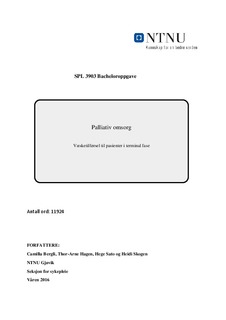| dc.contributor.advisor | Simonsen, Siri Gunn | |
| dc.contributor.author | Bergli, Camilla | |
| dc.contributor.author | Hagen, Thor-Arne | |
| dc.contributor.author | Sato, Hege | |
| dc.contributor.author | Skogen, Heidi | |
| dc.date.accessioned | 2016-09-08T06:54:58Z | |
| dc.date.available | 2016-09-08T06:54:58Z | |
| dc.date.issued | 2016-09-08 | |
| dc.identifier.uri | http://hdl.handle.net/11250/2405219 | |
| dc.description.abstract | Innledning: Væsketilførsel til terminale pasienter har vært et omdiskutert tema. I praksis er det ofte utydelig hva som er rett og galt i forhold til væsketilførsel. Det kan fort oppstå uenighet mellom lege/sykepleier og pårørende rundt dette temaet. Hensikt: Undersøke fordeler/ulemper med væsketilførsel til terminale pasienter. Metode: Denne studien har benyttet litteraturstudie som metode. Studien er basert på fem kvantitative og en kvalitativ studie, samt annen relevant litteratur. Resultat: Væsketilførsel bør vurderes i hvert pasienttilfelle. Det viser forskjeller i symptombildet ved ulike administrasjonsmåter. Konklusjon: Det tyder på at subkutan væsketilførsel har færre komplikasjoner enn intravenøs væsketilførsel. Det er sett viktigheten av munnstell i terminal fase, da subkutan/intravenøs væsketilførsel har vist seg og ikke ha effekt på munntørrhet, som følge av at pasienten puster med åpen munn. | nb_NO |
| dc.description.abstract | Introduction: Artificial hydration for terminally ill patients has been a debated topic. In practice, there is no right or wrong, concerning artificial hydration. Disagreements could easily occur between the doctors and nurses on one side and the families on the other. Purpose: Investigate advantages/disadvantages concerning artificial hydration for terminally ill patients. Method: This study is based on a literature study as method. The study is based on five quantitative and one qualitative study, as well as other relevant literature. Result: Artificial hydration should be considered for each patient. It is shown differences in symptomology for various routes of administration. Conclusion: There is an indication that it is fewer complications with subcutaneous administration than intravenous administration. It is seen the importance of mouth care in a terminal phase, because subcutaneous/intravenous administration has shown no effect on dry mouth. This is due to the fact that the patients are breathing with open mouth. | nb_NO |
| dc.language.iso | nob | nb_NO |
| dc.subject | Væsketilførsel | nb_NO |
| dc.subject | Terminal fase | nb_NO |
| dc.subject | Administrasjonmåte | nb_NO |
| dc.subject | Artifical hydration | nb_NO |
| dc.subject | Terminally ill patients | nb_NO |
| dc.subject | Management method | nb_NO |
| dc.title | Væsketilførsel i terminal fase: Fordeler og ulemper med væskebehandling i terminal fase. | nb_NO |
| dc.title.alternative | Artificial hydration in a terminal phase. | nb_NO |
| dc.type | Bachelor thesis | nb_NO |
| dc.subject.nsi | VDP::Medical disciplines: 700::Health sciences: 800::Nursing science: 808 | nb_NO |
| dc.source.pagenumber | 47 | nb_NO |
